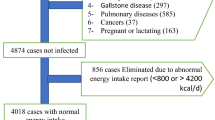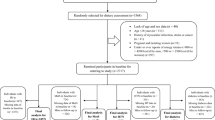Abstract
Background: Associations between dietary factors and glucose tolerance observed in Caucasian populations may not be applicable to Chinese populations, since the traditional Chinese diet contains plentiful vegetables and is rice-based (which has a lower glycemic index than potatoes). To address this question, the dietary patterns in 988 Hong Kong Chinese subjects with normal and impaired glucose tolerance, and diabetes, were examined in a cross sectional survey to determine if there is any association between diet and glucose tolerance.
Method: A stratified random population sample of 988 subjects (488 male, 500 female) was recruited. A food frequency questionnaire was used to determine dietary intake, and glucose tolerance was examined using the glucose tolerance test and the WHO criteria used to classify subjects into the three glucose tolerance categories.
Results: Using the standardized world population of Segi, the prevalence rate for DM was 6.6% for men and 5.7% for women; and for IGT 10.3% for men and 15.4% for women aged 30–64 y. Abnormal glucose tolerance is associated with female gender, older age, lower educational attainment and higher body mass index (BMI). No clear pattern of association with dietary factors was observed after adjusting for confounding factors. However, if subjects with BMI≥25 kg/m2 were excluded, an increase in mean consumption of rice/noodles/pasta per week was observed in the DM group, after adjusting for total energy intake and other confounding factors. No association between dietary variety, which has been linked with body fatness, and glucose tolerance, was observed.
Conclusion: Dietary habit may not be a strong risk factor for the development of glucose intolerance in Chinese populations, given the favorable features of the Chinese diet. The high consumption of rice in the DM subjects who are of normal BMI suggests that further studies examining glycemic indices of Chinese food items may be beneficial. Obesity still remains the most important predisposing factor.
This is a preview of subscription content, access via your institution
Access options
Subscribe to this journal
Receive 12 print issues and online access
$259.00 per year
only $21.58 per issue
Buy this article
- Purchase on Springer Link
- Instant access to full article PDF
Prices may be subject to local taxes which are calculated during checkout
Similar content being viewed by others
References
Cockram, CS, Woo, J & Lau, E et al (1993). The prevalence of diabetes mellitus and impaired glucose tolerance among Hong Kong Chinese adults of working age. Diabetes Res. Clin. Pract., 21, 67–73.
Feskens, EJM, Bowles, CH & Kromhout, D (1991). Carbohydrate intake and body mass index in relation to the risk of glucose tolerance in an elderly population. Am. J. Clin. Nutr., 54, 136–140.
Feskens, EJM, Virtanen, SM & Rasanen, L et al (1995). Dietary factors determining diabetes and impaired glucose tolerance: a 20 year follow-up of the Finnish and Dutch cohorts of the Seven Countries study. Diabetes Care, 18, 1104–1112.
Foster-Powell, K & Miller, JB (1995). International tables of glycemic index. Am. J. Clin. Nutr., 62, 871S–93S.
Holland, B, Welch, AA, Unwin, ID, Buss, DH, Paul, AA & Southgate, DAI (1992). McCance and Widdowson's: The Composition of Foods, 5th edn London: The Royal Society of Chemistry and Ministry of Agriculture, Fisheries and Food
Hu, FB, Manson, JE & Stampfer, MJ et al (2001). Diet, lifestyle, and the risk of type 2 diabetes mellitus in women. New Engl. J. Med., 345, 790–797.
Institute of Health (1992). Food Composition Tables, China: Chinese Medical Science Institute, Peoples Health Press (in Chinese)
Janus, ED, Wat, NMS, Lam, KSL, Siu, STS, Liu, LJ & Lam, TH for the Hong Kong Cardiovascular Risk Factor Steering Committee (2000). The prevalence of diabetes, association with cardiovascular risk factors and implications od diagnostic criteria (ADA 1997 and WHO 1998) in a 1996 community-based population study in Hong Kong Chinese. Diabetes Med., 17, 741–745.
Jenkins, DJA, Wolever, TMS & Jenkins, AL (1988). Starchy foods and glycemic index. Diabetes Care, 11, 149–159.
King, H & Rewers, M (1993). WHO Ad Hoc Diabetes Reporting Group. Global estimates for prevalence of Diabetes Mellitus and impaired glucose tolerance in adults. Diabetes Care, 16, 157–177.
Lee, WTK, Leung, SSF & Leung, DMK (1994). The current dietary practices of Hong Kong adolescents. Asia Pacific J. Clin. Nutr., 3, 83–87.
McCrory, MA, Fuss, PJ & McCallum, JE et al (1999). Dietary variety within food groups: association with energy intake and body fatness in men and women. Am. J. Clin. Nutr., 69, 440–447.
Morris, KL & Zemel, MB (1999). Glycemic index, cardiovascular disease, and obesity. Nutr. Rev., 57, 273–276.
Munoz, JM, Sandstead, HH & Jacob, RA (1979). Effects of dietary fiber on glucose tolerance of normal men. Diabetes, 28, 496–502.
Roberts, SB (2000). High-glycemic index foods, hunger and obesity: is there a connection?. Nutr. Rev., 56, 163–169.
Salmeron, J, Ascherio, A & Rimm, EB et al (1997). Dietary fiber, glycemic load, and risk of NIDDM in men. Diabetes Care, 20, 545–550.
Tsang, YS & Yung, SW (1991). Diet and Health Guide and Composition of Food in Southern China, China: ZhongShan University Press (in Chinese)
Williams, DEM, Wareham, NJ, Cox, BD, Byrne, CD, Hales, CN & Day, NE (1999). Frequent salad vegetable consumption is associated with a reduction in the risk of diabetes mellitus. J. Clin. Epidemiol., 52, 329–335.
Woo, J, Leung, SSF, Ho, SC, Lam, TH & Janus, ED (1997). A food frequency questionnaire for use in the Chinese population in Hong Kong: description and examination of validity. Nutr. Res., 17, 1633–1641.
Woo, J, Leung, SSF, Ho, SC, Sham, A, Lam, TH & Janus, ED (1999). Influence of educational level and marital status on dietary intake, obesity and other cardiovascular risk factors in a Hong Kong Chinese population. Eur. J. Clin. Nutr., 53, 461–467.
Woo, J, Woo, KS & Leung, SSF et al (2001). The Mediterranean score of dietary habits in Chinese populations in four different geographical areas. Eur. J. Clin. Nutr., 55, 215–220.
World Health Organization Study Group (1985). Diabetes Mellitus, Technical Report Series no. 727, pp9–14, Geneva: WHO
Author information
Authors and Affiliations
Corresponding author
Rights and permissions
About this article
Cite this article
Woo, J., Ho, S., Sham, A. et al. Diet and glucose tolerance in a Chinese population. Eur J Clin Nutr 57, 523–530 (2003). https://doi.org/10.1038/sj.ejcn.1601586
Received:
Revised:
Accepted:
Published:
Issue Date:
DOI: https://doi.org/10.1038/sj.ejcn.1601586
Keywords
This article is cited by
-
Food variety, dietary diversity, and type 2 diabetes in a multi-center cross-sectional study among Ghanaian migrants in Europe and their compatriots in Ghana: the RODAM study
European Journal of Nutrition (2018)
-
The abundance of fecal Faecalibacterium prausnitzii in relation to obesity and gender in Chinese adults
Archives of Microbiology (2014)
-
Dietary glycemic index and glycemic load in relation to HbA1c in Japanese obese adults: a cross-sectional analysis of the Saku Control Obesity Program
Nutrition & Metabolism (2012)



